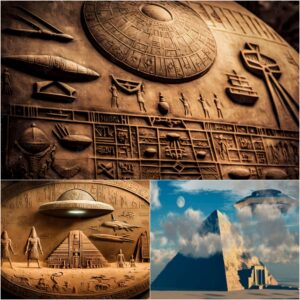
The notion that our Solar System isn’t exclusively ours is gaining ground as the years pass. Recent occurrences hint at the presence of extraterrestrial vessels patrolling the planets.
This sparks a multitude of inquiries: Are these planets theirs, prompting a defensive stance? Alternatively, are we perceived as a potential threat?
Compelling evidence points to the existence of ancient civilizations on the surfaces of the Moon and Mars. Earthly probes have captured glimpses of semi-buried and inactive alien structures and bases.
Mars’s red expanse extends across partially buried and dormant structures. Moreover, extraterrestrial vessels are observed patrolling and overseeing human activities on these celestial bodies.
For instance, NASA’s retired space shuttle engaged in missions where astronauts were pursued by UFOs shaped like saucers. Each of these objects exhibited a distinctive notch at the craft’s rear.
Astronauts aboard the International Space Station have also witnessed enigmatic UFOs. In fact, even NASA has been unable to decipher the nature of these sightings.

Certain researchers posit that these are patrol crafts, diligently surveilling military installations, space missions, and humanity’s gradual advancement.
They argue that these advanced civilizations are discontent with human actions. Evidence presented by former NASA employee Ken Johnston stirred controversy within the space agency, showcasing samples of alien structures on the Moon.
This narrative is further complicated by the attack suffered by the Soviet Union’s Fobos II spacecraft. The cylindrical object, over 20 kilometers long, was captured by the spacecraft patrolling Mars.
Since the 1800s, peculiar incidents have been reported on neighboring planets. Domes and lights traversing the Moon, mysterious flashes emanating from the clouds of Venus, or anomalous features materializing and dissipating on the Martian surface.
Now, more than fifty years into the space age, a wealth of evidence remains archived—concealed from public view.
The compilation of data reveals unmistakable images of an extensive extraterrestrial presence potentially spanning numerous light-years across the Sagittarius Arm of the Milky Way.
Similarly, a colossal extraterrestrial lunar base was uncovered within the Delisle crater. The image, published by NASA and taken by the Apollo 16 crew, is cataloged on NASA’s page as “figure 199.” It involves two craters, Delisle and Diophantus, with the former in the top right.
Upon magnification, peculiar structures that appear artificial become apparent at the base of the crater, at the bottom. The magnification minimally degrades the image, enabling high-resolution analysis of the image and its discernible artifacts.
Two enormous structures are observed, with the left one resembling a question mark. This is not a flaw in the image; the structure is three-dimensional and spans kilometers, exhibiting walls and easily identifiable architecture.
It’s plausible that advanced civilizations maintain bases for extraterrestrial craft. In this manner, all planets in the Solar System, including Earth, could be under constant patrol.





